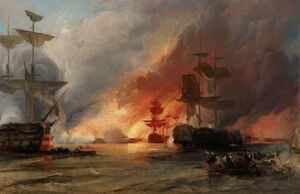Bashriyyan Barbary Wars
This article is incomplete because it is pending further input from participants, or it is a work-in-progress by one author. Please comment on this article's talk page to share your input, comments and questions. Note: To contribute to this article, you may need to seek help from the author(s) of this page. |
| Bashriyyan Barbary Wars | |||||||
|---|---|---|---|---|---|---|---|
| |||||||
| Belligerents | |||||||
| Bolrieg | Bashriyya | ||||||
| Commanders and leaders | |||||||
|
| N/A | ||||||
| Strength | |||||||
|
(ships) |
(ships) | ||||||
| Casualties and losses | |||||||
|
|
Bashriyya | ||||||
The barbary wars
Background
Able-bodied men, especially captured bodyguards, sailors or even a few unlike marines, were often pressed into service and forced to operate in "penal battalions" or "slave labor battalions" where they would be forced to carry extra supplies, dig trenches, set up camp, etc. Often times in combat, primarily in the Bashriyyan-Afruikahn Colonial Incursions but also in separate barbary wars with other coastal powers, they would be used as disposable "arrow fodder" to suck up the opening barrages of enemy forces (usually spears & arrows used by local Afruikahn warlords).
First Inyurstan Campaign
Operation Augillo Blanc
Battle of Tripoli Bay
Biron's Retreat
Second Inyurstan Campaign
With Biron's detachment regrouping off the coast of Bolreig, they were soon joined by Enriqué D'Andalucia arriving from Inyursta with fresh ships. In spite of the setbacks of the initial campaign, the Inyurstan Navy was ready to engage a renewed offensive against the barbary pirates and their Bashriyyan state supporters.
Battle of Halij Haraq
In order to strike at the Bashriyyan Sultan, the Inyurstan commanders deduced they would first have to destroy his navy. Given the ability of shore-borne artillery and excess locations to launch "suicide rafts", engaging them close to shore was considered too risky, and it was decided that the Bashriyyans should be engaged in open water.
Baiting Al-Monharaf
Fortunately, the Inyurstan retreat had left the Bashriyyan navy and barbary pirates alike believing they had effectively won the conflict and asserted their right to take ships and hostages. Playing further into the Inyurstan hands was that much of D'Andulcia's reinforcement fleet was comprised of former merchant vessels purchased or pressed into service after the conclusion of the Polaches-Juarez War, which allowed a group of three ships to effectively disguise themselves as a civilian merchant convoy.
On the night of the second day, Al-Monharaf had taken the bait. With four ships, including his own flagship, he moved in to assail and capture what they thought were merchant vessels. Unlike the daylight battle with Biron's contingent, the Bashriyyans did not engage at long range with their cannons nor did they dispatch suicide-rafts. Instead, a small number of durbish-assassins were sent in via raft to assassinate the ships captains & officers, as had been an effective tactic with earlier merchant ships and even the "gentleman's navies" of certain Eulabian nations. Effectively infiltrating the ships, the assassins were caught off guard to find the Inyurstans were awake and armed - and many of the officers they had been sent to slay were well-experienced in hand-to-hand combat - many in fact being former pirates themselves looking for an excuse to swordfight. As the hand-to-hand fighting began, the lower decks of the Inyurstan ships opened fire are nearly point-blank range with broadsides attacks against an unsuspecting enemy. One corsair vessel which was caught directly between the ships was destroyed almost outright, and another heavily damaged. Both sides then engaged in intense fighting. D'Andalucia then ordered the focused destruction of the heavily damaged Bashriyyan ship to turn the odds from 4 vs 3 to 2 vs 3. This strategy allowed one of his subordinate ships, La Barancalla, to break off and move to engage and entrap Al-Monharaf's flagship and prevent his escape.
With the odds suddenly turned against him, the Bashriyyan commander desperately signaled the remainder of his forces to engage in the fight.

